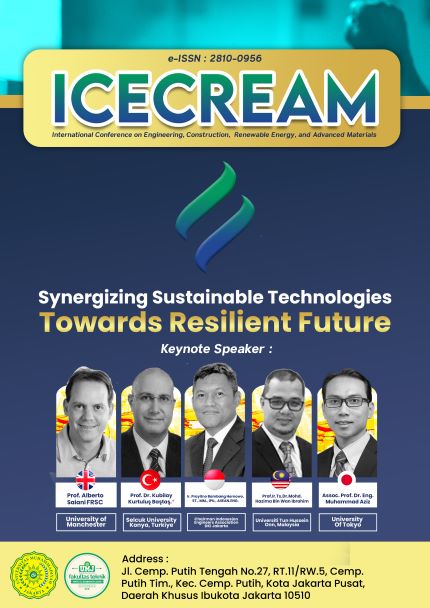Study of Potential PCL for Bone Screw with Enhancement Mechanical Strength through Annealing Process
Abstract
This study was carried out to assess the potential mechanical properties of PCL (Polycaprolactone) applied as bone screws. PCL is a biocompatible and biodegradable, this material could be absorbed by the human body when used as a bone screw. However, PCL does not have high enough mechanical strength and stiffness, a micro injection molding process will be used to make PCL bone screws. To improve the mechanical strength and stiffness of the molded PCL screw, annealing was applied after the screws were molded. The experimental results showed that the strength at yield of the molded specimen was 15.855 MPa and the young modulus was 1.98 GPa while those of the after annealing specimen were 17.366 MPa and 3.47 GPa, respectively. Indicates that micromolding of a PCL can be improved by proper annealing process.Keywords: Bone Screw, PCL (polycaprolactone), Micromolding Machine, Annealing, Tensile Test.References
M. S. Ghiasi, J. Chen, A. Vaziri, E. K. Rodriguez, and A. Nazarian, “Bone fracture healing in mechanobiological modeling: A review of principles and methods,” Bone Reports, vol. 6. Elsevier Inc, pp. 87–100, Jun. 01, 2017. doi: 10.1016/j.bonr.2017.03.002.
B. Hanson, C. Van Der Werken, and D. Stengel, “Surgeons’ beliefs and perceptions about removal of orthopaedic implants,” BMC Musculoskelet Disord, vol. 9, 2008, doi: 10.1186/1471-2474-9-73.
K. Hari Raj, S. Gnanavel, and S. Ramalingam, “Investigation of 3D printed biodegradable PLA orthopedic screw and surface modified with nanocomposites (Ti–Zr) for biocompatibility,” Ceram Int, vol. 49, no. 5, pp. 7299–7307, Mar. 2023, doi: 10.1016/j.ceramint.2022.10.188.
F. A. Müller, L. Müller, I. Hofmann, P. Greil, M. M. Wenzel, and R. Staudenmaier, “Cellulose-based scaffold materials for cartilage tissue engineering,” Biomaterials, vol. 27, no. 21, pp. 3955–3963, Jul. 2006, doi: 10.1016/j.biomaterials.2006.02.031.
M. A. Woodruff and D. W. Hutmacher, “The return of a forgotten polymer - Polycaprolactone in the 21st century,” Progress in Polymer Science (Oxford), vol. 35, no. 10. Elsevier Ltd, pp. 1217–1256, 2010. doi: 10.1016/j.progpolymsci.2010.04.002.
R. Chandra and R. Rustgi, “B I O D E G R A D A B L E P O L Y M E R S,” 1998.
L. S. Nair and C. T. Laurencin, “Biodegradable polymers as biomaterials,” Progress in Polymer Science (Oxford), vol. 32, no. 8–9. pp. 762–798, Aug. 2007. doi: 10.1016/j.progpolymsci.2007.05.017.
M. Okada, “Chemical syntheses of biodegradable polymers.” [Online]. Available: www.elsevier.com/locate/ppolysci
R. Chandra and R. Rustgi, “BIODEGRADABLE POLYMERS,” 1998.
E. Salehi, P. Daraei, and A. Arabi Shamsabadi, “A review on chitosan-based adsorptive membranes,” Carbohydrate Polymers, vol. 152. Elsevier Ltd, pp. 419–432, Nov. 05, 2016. doi: 10.1016/j.carbpol.2016.07.033.
R. Sainitya et al., “Scaffolds containing chitosan/carboxymethyl cellulose/mesoporous wollastonite for bone tissue engineering,” Int J Biol Macromol, vol. 80, pp. 481–488, Sep. 2015, doi: 10.1016/j.ijbiomac.2015.07.016.
Z. Han and C. Chang, “Fabrication and Thermal Performance of a Polymer-Based Flexible Oscillating Heat Pipe via 3D Printing Technology,” Polymers (Basel), vol. 15, no. 2, Jan. 2023, doi: 10.3390/polym15020414.
P. Sarazin, G. Li, W. J. Orts, and B. D. Favis, “Binary and ternary blends of polylactide, polycaprolactone and thermoplastic starch,” Polymer (Guildf), vol. 49, no. 2, pp. 599–609, Jan. 2008, doi: 10.1016/j.polymer.2007.11.029.
J. M. Raquez, Y. Habibi, M. Murariu, and P. Dubois, “Polylactide (PLA)-based nanocomposites,” Progress in Polymer Science, vol. 38, no. 10–11. Elsevier Ltd, pp. 1504–1542, 2013. doi: 10.1016/j.progpolymsci.2013.05.014.
R. Renstad, S. Karlsson, A. Sandgren, and A.-C. Albertsson, “Influence of Processing Additives on the Degradation of Melt-Pressed Films of Poly(e-Caprolactone) and Poly(Lactic Acid),” 1998.
I. Moura, A. V. MacHado, F. M. Duarte, and R. Nogueira, “Biodegradability assessment of aliphatic polyesters-based blends using standard methods,” J Appl Polym Sci, vol. 119, no. 6, pp. 3338–3346, Mar. 2011, doi: 10.1002/app.32966.
K. Fukushima, C. Abbate, D. Tabuani, M. Gennari, P. Rizzarelli, and G. Camino, “Biodegradation trend of poly(ε-caprolactone) and nanocomposites,” Materials Science and Engineering C, vol. 30, no. 4, pp. 566–574, May 2010, doi: 10.1016/j.msec.2010.02.012.

